Comets Middleweights — 2005 Season In Review
January 23rd, 2006
In the off-season, I’d spent countless hours studying Jim Ahern’s Spread SW because I thought we could use it to make the best use of the talent we would have. Now, as the season approached, I learned that the golden-armed quarterback and the quick halfback from the Comets’ 2004 Middleweight Super Bowl team were moving up to Heavyweight, even though their ages and weights made them eligible to play for us. I didn’t need to ask for an explanation. The Heavyweights were going to have a terrific team this season and these boys wanted to be a part of it. But it said something about what people expected from the 11-12 year olds I’d be coaching.
We held a clinic in late June and I got a good look at a lot of our players at that time. I have to confess it was hard to get overly excited. There were some pretty decent athletes, but no one with blazing speed and not much size either. There were a lot of kids in the 70-90 LB. range. It seemed to me that Spread Single Wing might still be the way to go with this undersized group.
I had to deal with the matter of getting assistant coaches. We had huge numbers for our little community — 64 players — to be divided between one A team and two B teams. At the start of equipment pickup I only had one assistant coach. We recruited a bunch of dads that day, but they had no experience at all. Luckily we got a young (25) but experienced defensive coordinator (James) and an experienced offensive line coach (Ralph) within a few days of the start of practice.
During the first few weeks of practice, it became obvious that we were going to have to do more than run from Spread. We scrimmaged an 8th grade team from another league and we did OK, but the Power series I’d envisioned running from Spread was UGLY. We couldn’t get outside at all, except on the Spin Wingback Sweep and we looked pathetic going off-tackle. We did have decent a Tailback Wedge though. With a week left before the first game, I decided put in the Power series and Motion Weak series from a Tight Single Wing. I realized that our offense had mutated into something very similar to what Vic Coates ran with his freshmen at Stonewall Jackson High School a few years ago. If I recall his presentation at the 2002 Single Wing Symposium, he called it the “Jim & Dan Offense” after Coaches Ahern and Johnson. The difference was that Vic had a serious passer and some fairly fast receivers. We didn’t. What we did have was an offensive line that executed well, a hard running tailback, a couple good left-handed centers and a quarterback that showed some promise with the Spin series. (Note: we call the traditional Single Wing fullback the quarterback and the traditional Single Wing blocking back the fullback — this makes the local high school coach happy because we’re “developing quarterbacks”). Ralph was doing an awesome job of teaching the linemen our down block (Severe Anlge Blocking) and pull scheme and the boys were doing a good job with the wedge also. We started subbing out the wingback, blocking back and power end every time we changed from Spread to Tight or vice versa. This evened out some of the playing time and gave us more size for the Tight Single Wing and more speed and receiving skill for the Spread SW.
We expected our first game vs. the Wolves to be one of the toughest all season, but it wasn’t. Our offensive line just blew them off the ball on the Power Tailback Wedge. They looked like a snow plow clearing the way. James had installed a very aggressive blitzing 4-4 and our opponents had no answer for it. We took advantage of the Wolves’ turnovers and a recovered onside kick to put up four quick touchdowns and take a 24-0 halftime lead. We called another Power Tailback Wedge for a 55-yard touchdown on the first play of the second half. That put the game into slaughter rule at 31-0 and that’s how it ended.
In Game 2, we faced a pretty weak opponent (H-Raiders). Our third string wingback followed his blocking really well and returned the opening kickoff for a 75-yard touchdown. We ran nothing but Power series from Tight formation. Our tailback had 6 carries for over 200 yards and 5 touchdowns, all in the first half. The score was 46-6 at halftime. Running clock slaughter rule and no starters on the field in the second half. 48-6 final score. 2-0 record, so far so good.
Our Week 3 opponent (Badgers) had lost 20-0 in Week 1, but won 58-0 in Week 2. It didn’t make sense and unfortunately, after their Week 1 loss, I didn’t think it would be necessary to scout them in Week 2. The Badgers coach told me at the weigh in that the loss was because four of his best players didn’t make weight. Even so, we went into the game brimming with confidence. We were in for a rude awakening. When we kicked off, the kid that got the ball showed speed and strength we weren’t expecting. It turned out he was their tailback and it soon became obvious that he was the best player in the league. We managed to corral him on their opening drive, but we got a dumb clipping penalty on our punt return and ended up deep in our own territory. We drove the length of the field, but we turned it over on downs at their 10 thanks to another dumb clipping penalty. The Badgers tailback broke for three long touchdown runs on us in the first half. Fortunately, two of them were called back for flagrant clips. After they scored the touchdown that counted, we bounced back with a touchdown drive to make 6-6 at the half, but at halftime I could tell that our boys’ confidence was shaken. The Badgers were bigger and faster than us, they were out-hitting us and they were the ones brimming with confidence going into the second half. After our opening second half drive stalled due to poor execution, the Badgers fullback ripped off a long touchdown run to make it 12-6. We threw an interception on the next series. Our defense bent, but didn’t break and we got the ball back on our 20 with 4:00 left in the game. It was our chance to win the game, but it was going to be tough to mount a quick drive against the Badgers’ speed. With help from a pass interference penalty, we drove to their 35, but with 2 timeouts gone and only a 0:40 left, we needed a big play. We tried a Spread Wheel Pass, but it was underthrown and they picked it off.
We needed to bounce back in Week 4 vs. the Wildcats. Their offensive scheme was weak and they only had one kid with any speed. That made it almost impossible for them to score on our defense. Offensively, we played our worst game of the season. One big Spin Wingback Sweep to the weakside for a long touchdown and one Spin Quarterback Trap for a short touchdown and that was it. We committed three or four turnovers. A very ugly 12-0 win. To make matters worse we had two starters taken to the hospital from the field. One would be out for the season. Our boys started celebrating on the field after the game. After a pitiful offensive effort like that, it really ticked me off. I took them off the field and yelled at them for about 15 minutes. The emphasis was that a Single Wing team has to be able to run the ball consistently off-tackle. It didn’t do us much good to overwhelm the point of attack if our lead blockers didn’t hit people and our tailback didn’t follow them.
In our Week 5 practices we spent at least three hours drilling proper execution of the Power Series, especially the Tailback Off-Tackle. We did a Saturday morning video session to review our mistakes vs. the Badgers and Wildcats. I felt much better going into this game. Our execution was sharp, other than a couple of stupid turnovers. We wiped out a relatively weak opponent (J-Hawks) 34-0. Lots of playing time for the backups.
In Week 6, we faced the Bulldogs at their high school’s brand new field turf stadium. There was a huge downpour right before the game. The Bulldogs were the team that had beaten the Badgers in Week 1, and they were 5-0 going into this game. We had video of them and they just didn’t look that tough. They weren’t. Even though we committed three ridiculous turnovers, we mopped up the field turf with them 28-0. Our offensive line was just quicker and more aggressive than theirs. Other than our propensity to commit turnovers, things were starting to come together for our offense. We had two long touchdown passes (play action passes where we got the receiver behind the defense). We also made four sustained drives (unfortunately two of them were halted by turnovers). As we shook hands after the game, the Bulldogs’ coach said “Geez, talk about having your line dominate a game on both sides of the ball”.
Week 7’s opponent was the Crusaders. We traveled 40 miles to their high school’s muddy field, tucked in an urban neighborhood. The field got muddier thanks to a thirrd quarter thunderstorm, which forced us to temporarily evacuate. They played all eleven men up early in the game, so we passed. Their safety stripped the ball away from our quick end after a 25-yard completion and then the Crusaders hit us with a long touchdown pass. We were stunned to be behind 6-0. We came back with three touchdowns, two of them on play action pass plays, to go up 20-6 at the half. We put two more scores up early in the third to make it 34-6 at the thunderstorm break. One of them was a beautiful Spin Wingback Sweep for about 35 yards. Our backup tailback tore them up on wedges and off-tackle plays in the fourth quarter. The final was 42-12.
We finished the regular season 6-1, but lost the North Division championship tie-breaker to the Badgers based upon head-to-head.
In Round 1 of the playoffs we faced the Wildcats again. This time our execution was good. We rolled over them with two long first half touchdown drives to go up 16-0. We noticed that when we lined up in Spread that their best linebacker shifted out to cover our fullback man-to-man. We had the quick end and the fullback line up extra wide in Spread and we ran a bunch of Spin Tailback Wedges. The middle opened up wide and their best player was too far away to stop the play. We scored midway through the third on another long drive and on the Wildcats next series our safety picked off a pass and returned it about 60 yards for a touchdown. It was one of the more spectacular runs I’ve ever seen by an 11-year old. Slaughter rule. The final score was 32-0.
In Round 2 we faced the South Division Champion CL Raiders with a record of 8-0. They were a really big strong team, but they didn’t have a ton of speed. We drove the ball on them very well, especially off-tackle. We scored first on a 65-yard drive, but they surprised us with an impressive drive of their own to make it 8-8. We dominated the second quarter, but we fumbled once and also had a 75-yard touchdown run (Spin Tailback Wedge again) called back on a really stupid holding penalty. At the half, we stressed to the players that we would beat the Raiders with off-tackle plays and wedges if we’d just execute and hang on to the ball. The Raiders fumbled at their own 30 on their opening second half series and we drove it in to go up 16-8. We stopped them on the next series and drove to their 15, but we fumbled again. I was really getting frustrated. The Super Bowl had been within our grasp for two full quarters, but we weren’t showing any killer instinct. Finally, we got a break when our quarterback made a great scramble for about 20 yards on fourth down to keep a drive going. Our fullback clinched the 22-8 win with a great run on a Motion Weak Fullback Counter.
As we prepared to face the Badgers in the Super Bowl, we kept reminding the kids that they needed to keep the tailback contained and play mistake-free football. The Badgers had annihilated every opponent they’d faced since they beat us 12-6 in Week 3. On the day before the game we had a get together with the players. We showed them video of our 2001 Middleweights winning the Super Bowl as an example of intensity. We displayed some of our previous championship trophies in the room to remind them about Comet tradition. We watched as well as three of the Badgers’ games. I made an impassioned speech about the level of intensity we’d need to play with to win the game. The Badgers were more talented than us. If we were going to have a chance to win we’d need to play our absolute best.
It was really windy, so we knew passing would be tough. The game was on the Bulldogs’ field turf field, which probably favored the Badgers’ speed. We took the opening kickoff and ran nothing but wedges and off-tackle plays. Our tailback broke one of the wedge plays for about 50 yards down to the Badgers’ 8. Two plays later, we scored on a Spin Fullback Wedge to take a 6-0 lead. But any dreams we had of a championship began to fade after that. Their tailback went 70 yards for a touchdown and they made the kick to go up 8-6. We drove about 40 yards after the ensuing kickoff, but we turned it over on downs. Their tailback came back with another 70-yard toss sweep touchdown to put us down 16-6. We ran out of time trying to score before the half. We kicked to them to start the second half and then pushed them back from their 40 to their 6 on penalties and tackles for losses. I was thinking we had a chance to get back in the game, but on third down and 44, their tailback took a handoff on a blast play, quickly bounced it outside and was gone on a 94-yard touchdown run. Then our kickoff return team got sloppy and allowed the Badgers to recover an onside kick. They followed it up with a 5-play touchdown drive. 32-6. Basically game over. Early in the fourth their tailback/linebacker picked off a pass and went 45 yards for his fifth touchdown of the game. We bounced back with a quick 60-yard drive (it had to be quick because we were in slaughter rule with a running clock) for a toucdown to make the final score 38-12.
There were a lot of tears after the game, tears of frustration and embarrassment. Our players and coaches had worked their butts off since the summer to win a championship. We made it to the big game, but we got humbled. Our opponents had the best player in the league with a solid supporting cast and they played great when it counted. No matter, second place stinks. My voice quivered, choking back my own tears, as I spoke to the players. I reminded them that at the beginning of the season nobody thought we’d make it to the championship game. We’d given it our best and we could be proud of that. I told them to look at the joy that the Badgers displayed as they ran a victory lap around the field, holding their championship trophy high. We needed to take the pain we were feeling at that moment and use it as motivation to win the championship next season. Motivation to become bigger, faster, stronger and better football players in the off-season. Motivation to become better coaches too. To do everything we can improve our schemes, our planning and our organization. By the time I got those words out I was a basket case. Thankfully Ralph took over for me and finished it the speech.
Two months later, as I compile our highlight video, I feel pretty good about what we accomplished in 2005. Let the planning, organizing and scheming for 2006 begin.
Eric Strutz
Stateline Comets (IL)
Interview with Coach Joe Blount
January 9th, 2006
Interview with Coach Joe Blount, author of “The Smorgasbord Offense For Winning High School Football”
By Bill Statz
I have known Coach Blount for many years. I looked him up after reading his Athletic Journal article of 1949, “Short on Material, Try the Short Punt.” In that first discussion Coach Blount told me he wrote a book on his offense. Of course it was out of print, but after a decade I was able to purchase a located book.
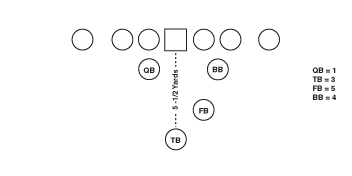
From the Smorgasbord, Coach Blount could line up in the Short Punt, Single Wing, Double Wing, Triple Wing, “Y” Formation and the “Shotgun” Formation. Coach Blount wrote his book in 1965. He said he was having coffee with his former Texas teammate, Tom Landry, when he suggested to Landry to run his “Shotgun” formation prior to the 1969 season. On page 57 of his book, Coach Blount writes about the “Shotgun” formation which came from TCU’s Coach Leo “Dutch” Meyer’s TCU Spread formation.
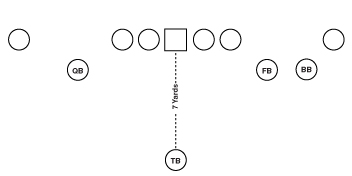
Coach Blount used the Short Punt formation 65-70% of the time. He liked the balance it provided. The backfield would be 1-1/2 men to the weak side and 2-1/2 men to the strong side.

Coach Blount could create other formations with different placements of the quarterback and/or blocking back. One such formation is SMU’s old “Y” Formation which was a favorite of Coach Matty Bell.
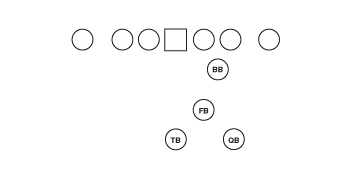
Coach Blount’s favorite play was “36″ and “Flip-Flop 36″. This is his power off-tackle play. The fullback and blocking back execute a running double team block on the defensive end while the quarterback and back side guard would lead through the hole. “Flip-Flop 36″ entailed flip-flopping the offense’s strong right side to the left side and running against the defense’s weaker personnel.
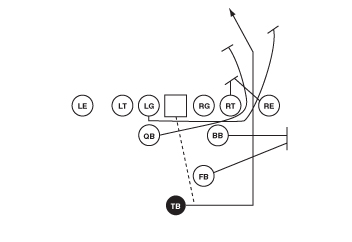
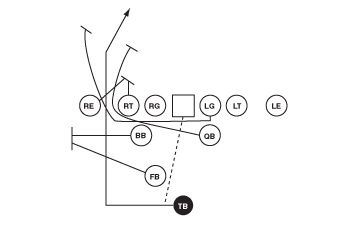
Coach Blount would love to talk to anyone interested in the Short Punt or other offenses from his “Smorgasbord”.
Coach Joe Blount
2702 Fran Street
Diana, TX 75640
(903) 663-4179
If anyone is interested in more information about the Short Punt please contact me.
Bill Statz
205 Sand Creek Drive
Winnsboro, SC 29180
(803) 633-0145
[email protected]